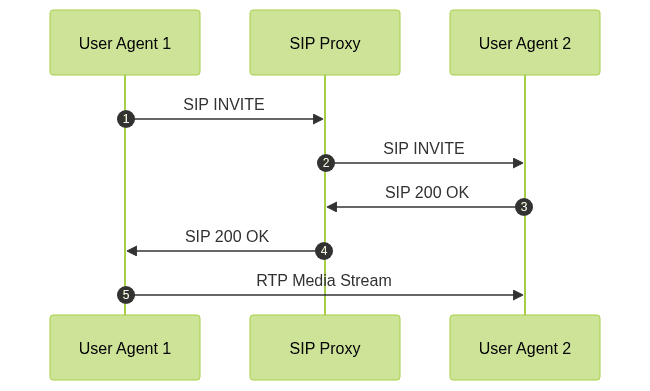Introduction: Understanding SIP and RTP in VoIP
Voice over IP (VoIP) has transformed the landscape of real-time communication by enabling voice and video calls over data networks. At the core of every successful VoIP implementation are two fundamental protocols: Session Initiation Protocol (SIP) and Real-time Transport Protocol (RTP). Understanding how SIP and RTP work together is essential for developers and engineers building resilient, high-quality communication systems in 2025 and beyond.
This blog post will demystify how SIP and RTP function, their roles in VoIP, and how they interact to deliver seamless audio and video streams. We’ll explore SIP signaling, RTP data transfer, practical implementation tips, troubleshooting strategies, and security considerations—giving you a comprehensive understanding of real-time communication protocols.
What is SIP? (Session Initiation Protocol)
SIP in VoIP Protocols
SIP is a signaling protocol standardized by the IETF, primarily used to initiate, modify, and terminate multimedia sessions such as voice and video calls over IP networks. Unlike RTP, which actually carries the media, SIP manages the setup and teardown of sessions. In the VoIP protocol stack, SIP is responsible for signaling, negotiating capabilities, and ensuring both endpoints are ready to communicate. For developers looking to integrate calling features, leveraging a
phone call api
can streamline SIP-based implementations.Key Functions of SIP
SIP performs several critical functions in VoIP systems:
- User Location: Determines the recipient’s current IP address.
- User Availability: Checks if the recipient is available for a session.
- User Capabilities: Negotiates codecs and media types using SDP (Session Description Protocol).
- Session Management: Handles call setup, modification, and termination, as well as session transfers and call holding.
SIP Architecture & Components
SIP networks comprise several logical components:
- User Agent (UA): SIP client or server initiating and receiving calls.
- Proxy Server: Routes SIP requests to the appropriate destination.
- Registrar Server: Handles SIP registration and user location.
- Redirect Server: Directs clients to contact alternate locations.

How Does SIP Work?
SIP Call Flow Explained
The core of how SIP works is its message-based transaction system. Here’s a simplified SIP call flow between two user agents:
1INVITE sip:alice@example.com SIP/2.0
2Via: SIP/2.0/UDP pc33.example.com;branch=z9hG4bK776asdhds
3Max-Forwards: 70
4To: <sip:alice@example.com>
5From: <sip:bob@example.com>;tag=456248
6Call-ID: 843817637684230@998sdasdh09
7CSeq: 1826 INVITE
8Contact: <sip:bob@pc33.example.com>
9Content-Type: application/sdp
10Content-Length: ...
11
12-- SDP body --
13
14// Response
15SIP/2.0 200 OK
16Via: SIP/2.0/UDP pc33.example.com;branch=z9hG4bK776asdhds
17To: <sip:alice@example.com>;tag=1928301774
18From: <sip:bob@example.com>;tag=456248
19Call-ID: 843817637684230@998sdasdh09
20CSeq: 1826 INVITE
21Contact: <sip:alice@host.example.com>
22Content-Type: application/sdp
23Content-Length: ...
24
25-- SDP body --
26This flow illustrates the SIP INVITE and 200 OK responses, setting up the session parameters for the call. If you're building advanced call features for mobile platforms, you might find a
callkit tutorial
helpful for seamless integration on iOS devices.SIP Headers and SDP
SIP headers carry crucial information about the message, participants, and call state. The Session Description Protocol (SDP) is typically embedded in the SIP message body to negotiate media types, codecs, and transfer addresses, enabling media negotiation and session setup.
SIP Response Codes
SIP uses response codes similar to HTTP, such as:
- 100 Trying: Call is being processed
- 180 Ringing: Destination is ringing
- 200 OK: Request succeeded
- 486 Busy Here: User is busy
What is RTP? (Real-time Transport Protocol)
RTP in VoIP Protocols
While SIP takes care of signaling, RTP is responsible for the actual transfer of media data—audio and video streams—between endpoints. RTP is designed for real-time, low-latency communication and is widely used in VoIP, video conferencing, and streaming applications in 2025. Developers looking to add video features can benefit from a robust
Video Calling API
that leverages RTP for high-quality media transport.RTP Packet Structure
An RTP packet consists of a fixed header and a variable payload (the actual media data). Key fields include sequence numbers, timestamps, and SSRC identifiers.
1# Example RTP packet structure (simplified)
2rtypacket = {
3 "version": 2,
4 "padding": 0,
5 "extension": 0,
6 "cc": 0,
7 "marker": 0,
8 "payload_type": 0,
9 "sequence_number": 3456,
10 "timestamp": 12345678,
11 "ssrc": 0x3A1B2C3D,
12 "payload": b"\\x80\\xe0..."
13}
14- Header: Protocol version, marker, payload type
- Payload: Encoded voice/video data
- Sequence Number: Detects packet loss, maintains order
- Timestamp: Synchronizes playback
- SSRC/CSRC: Identifies source(s) of the stream
How Does RTP Work?
Establishing RTP Streams
RTP streams are negotiated through SIP using SDP during the session setup phase. Both endpoints exchange their supported codecs, media types, and network addresses. Once the SIP signaling completes, RTP streams flow directly between endpoints (peer-to-peer), independent of SIP proxies. For developers working with cross-platform solutions, exploring
flutter webrtc
can be valuable for building real-time communication apps in Flutter.RTP/RTCP Functionality
RTP is often paired with the Real-time Transport Control Protocol (RTCP), which provides feedback on quality of service (QoS), packet loss, jitter, and round-trip time. RTCP supports:
- Monitoring transmission statistics
- Synchronizing multiple streams (e.g., audio and video)
- Adaptive jitter buffering
If you're interested in building audio-focused experiences, using a
Voice SDK
can simplify the process of integrating real-time voice features with RTP and RTCP support.RTP Synchronization, Jitter, and Packet Loss
Synchronization ensures audio/video alignment; jitter and packet loss can degrade quality. Tools like RTCP statistics and adaptive jitter buffers help mitigate these issues, ensuring a smoother real-time communication experience. For web-based implementations, a
javascript video and audio calling sdk
can accelerate development and ensure robust RTP handling.SIP and RTP Working Together
SIP for Call Setup, RTP for Media Transport
SIP and RTP are complementary—SIP establishes the session, and RTP carries the media. Here’s a workflow diagram:

Full SIP/RTP Call Flow Example
Let’s tie it together with an end-to-end call lifecycle:
1// SIP signaling
2UA1 sends INVITE to Proxy
3Proxy forwards INVITE to UA2
4UA2 replies with 200 OK
5Proxy relays 200 OK to UA1
6UA1 sends ACK to UA2
7
8// RTP media
9UA1 and UA2 exchange RTP packets directly:
10RTP Packet: {
11 version: 2, sequence_number: 10001, timestamp: 123456, payload: "\\x80..."
12}
13
14// Call ends with BYE request
15UA1 sends BYE to UA2 via Proxy
16UA2 replies with 200 OK
17This illustrates how SIP manages the call lifecycle (setup, negotiation, teardown), while RTP handles continuous media streaming. If you want to
embed video calling sdk
functionality directly into your application, prebuilt solutions can help you quickly implement SIP and RTP-based communication.SIP vs RTP: Protocol Differences
- SIP: Signaling (call setup, negotiation, teardown), text-based
- RTP: Media transport (audio/video), binary data packets
- RTCP: Quality monitoring, feedback
Practical Implementation and Troubleshooting
Implementing SIP and RTP in VoIP Systems
For a robust VoIP deployment, follow these practices:
- Use SIP proxies for routing and scalability
- Ensure endpoint registration is reliable
- Carefully configure NAT traversal (STUN, TURN, ICE)
- Optimize codec selection for bandwidth and quality
If you're developing for Android, understanding
webrtc android
best practices can help you overcome platform-specific challenges and ensure smooth SIP and RTP integration.Common Issues: NAT, Firewall, QoS
SIP and RTP can be disrupted by network address translation (NAT) and firewalls. Strategies include:
- Enable SIP ALG or configure port forwarding
- Use ICE protocol for NAT traversal
- Monitor and prioritize RTP traffic for QoS, minimizing packet loss and jitter
For those building comprehensive communication platforms, integrating a
Video Calling API
can provide advanced features like multi-party video and screen sharing, all while handling SIP and RTP complexities under the hood.Security Considerations
- SIP Authentication: Use strong passwords and digest authentication
- RTP Encryption: Deploy SRTP (Secure RTP) to encrypt media streams and protect against eavesdropping
If you need to add calling features to your app, a reliable
phone call api
can help ensure secure and scalable SIP and RTP integration.Tools for Monitoring SIP and RTP
- Wireshark: Deep packet inspection, protocol analysis
- SIPp: SIP traffic generation and testing
- VoIPmonitor, Homer: Real-time monitoring and troubleshooting
Conclusion: Mastering SIP and RTP for Real-time Communication
Understanding how SIP and RTP work together is fundamental for building, maintaining, and troubleshooting modern VoIP systems in 2025. SIP manages session setup, negotiation, and teardown, while RTP delivers real-time audio and video. Mastery of these protocols ensures high-quality, secure, and reliable communication—critical for businesses and developers alike.
Want to level-up your learning? Subscribe now
Subscribe to our newsletter for more tech based insights
FAQ